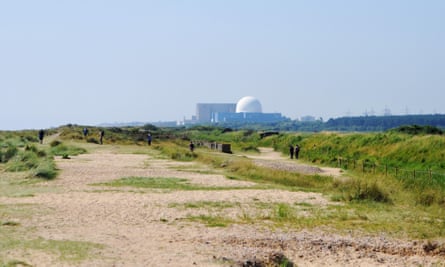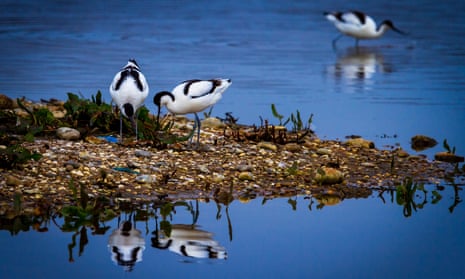The Bittern Hide at the RSPB’s Minsmere reserve was doing steady business last Wednesday. More than a dozen birdwatchers were crammed into the elevated shelter which overlooks a broad band of heath, freshwater pools and reed beds stretching to the Suffolk coast. Marsh harriers swirled overhead and an occasional bittern swept across the landscape. In front of another nearby hide, avocets waded leisurely across a lagoon. Minsmere is an ornithologist’s paradise.
But a threat hangs over its wildlife glories. In a few days, the government is set to announce its decision on whether to allow the Sizewell C nuclear power plant to be built by EDF on land that overlooks the 1,000-hectare (2,500-acre) reserve.
Approval will trigger the go-ahead for one of Europe’s biggest construction projects, and the impact on the reserve will be intense. New roads and a temporary port may be built, and dozens of huge cranes erected across land that borders Minsmere. For at least a decade, construction of the giant plant’s twin nuclear reactors will proceed – day and night.
“We are not opposed to the principle of there being energy infrastructure at the Sizewell site but the likely impact of this particular project could be very damaging,” said Adam Rowlands, Suffolk area manager for the RSPB. “There is a real threat to species that we have struggled to preserve here.”
Minsmere, which is celebrating its 75th anniversary this year, is rated as one of the UK’s finest wildlife reserves, though its origins are unusual. At the beginning of the second world war, it was decided the area’s low-lying farmland should be flooded as a protection against German invasion. After the war ended, it was discovered that avocets, which had been extinct in the UK for more than 100 years, had started nesting there.
“At the time, there was all sorts of pressure being put on landowners to drain land and boost food production in the UK in the years after the war,” added Rowlands.
“However, in the end it was decided to keep the area as a natural mix of shingle beaches, coastal lagoons, grazing marshes and woodland. The RSPB took this over in 1947. Essentially, the land was rewilded, long before the term became an ecological buzzword.”

Many rare species, such as the marsh harrier and the bittern, found precious refuge at Minsmere. However, it was the return of the avocet that had the greatest impact. After a century’s absence from Britain, the black-and-white wader, with its distinctive up-curved beak, established a small colony at Minsmere. From there it spread slowly across the nation. Today, there are about 1,500 breeding pairs in the UK and the bird is now depicted in the RSPB’s emblem, a symbol of hope in the cause of saving threatened bird species.
Nor are avocets, bitterns and marsh harriers the only Minsmere residents. Otters, water voles, kingfishers, nightjars, woodlarks, Dartford warblers, adders, natterjack toads and silver-studded blue butterflies have also made homes on the reserve. “It is the range of habitats that makes Minsmere special,” said Rowlands. “There are reed beds, wet grassland, ditches, coastal shingle, woodland, heather heathland and acid grassland. This is a precious space.”
The prospect of a vast construction project proceeding on adjacent land, therefore, causes concerns. In Somerset, where EDF is building the Hinkley Point C nuclear plant, about 1,600 workers are on site every day; 3m tonnes of concrete and 230,000 tonnes of steel will eventually be used to make the new power plant while the site is dominated by giant 40-metre (130ft) cranes. The construction of its twin at Sizewell C will be identical in scale.
Sizewell C will also require vast amounts of water for its workers, and to make the concrete needed for its construction. It is not clear where this water will come from in an area where supplies are already stretched.

After its completion, even greater amounts will be needed to cool its reactors. “There is also the issue of the warm water leaving the reactor,” said Rowlands. “That could have a significant impact on the marine environment on the coast at Minsmere, affecting the populations of fish and shellfish there and the birds that feed on them.”
After nine years’ construction, Hinkley Point C is now two years behind schedule and £8bn over budget although EDF has argued that the lessons it is learning in constructing the Somerset plant will be crucial in keeping Sizewell C – which would provide electricity for 6m homes in Britain – on target in terms of cost and schedule.
The company says it is already planting trees along its boundary with the reserve to protect Minsmere and it has also created 47 hectares of new habitats for foraging marsh harriers to the north of the construction site.
“Climate change is one of the biggest threats to biodiversity, and Sizewell will play a big role in tackling the carbon emissions that are driving that change,” said an EDF spokesperson. “We have to get to achieve net-zero carbon emissions, and – combined with Hinkley Point C and further nuclear projects – Sizewell C will play a key role in getting us there.”
Nevertheless, the RSPB remains concerned about the likely impact on the reserve it considers to be a jewel in its crown. “There are plans to have a new port, a massive new road and a new rail line built into the land beside this reserve in order to construct Sizewell C,” said Rowlands.
“That is going to make it very, very difficult for us to preserve an absolutely glorious region where people can observe some of Britain’s finest wildlife.”
